We are significantly behind in our rainfall totals for this year, but during the last week the rains have made a valiant effort to catch up before Spring arrives.

Although we enjoyed the recent warm weather, we're grateful for the return of the rains (click any image to enlarge)
This winter’s paucity of rainfall has impacted a number of our native plants, especially our deciduous fern species, including the Goldback Fern.
Pentagramma triangularis (syn. Pityrogramma triangularis) is a member of the Brake family of ferns (Pteridaceae), and related to our native California Maidenhair Ferns (Adiantum jordanii) that also grow on the farm.
Penta, meaning five, and gramma meaning lined, this species is named for its five-lobed, broadly triangular fronds.
The common name of Goldback, or Goldenback Fern, is an accurate descriptor of this species, because when a mature leaf is turned over, golden yellow waxy spores are visible on the underside of the fern’s fronds.
Native to the western United States, this species can be found growing from British Columbia, south throughout California, and east to Nevada and Idaho, growing below 7,500 feet in elevation.
This species favors dry brushy areas, and rocky slopes, and is frequently found growing in the understory of oak and mixed evergreen forests on rocky outcroppings and road cuts.
However, Goldback Fern’s diminutive size makes this particular species very easy to overlook.
This is the smallest species of fern that is known to grow on the farm. During the winter months we find it growing on some of the steepest banks above the road, mixed in with various grasses.
In the summer months however, without water, this fern becomes dormant, and seems to all but disappear.
Despite its preference for rocky exposed areas, Goldback Fern also tolerates significant shade, and occasionally we find it tucked in between the native redwood sorrel leaves, beneath the oaks. It rarely seems to thrive there, however.
We primarily find this fern growing beneath Live Oaks, and California Bay Laurels, but not under our Coast Redwoods. The Goldback Fern seems to resent the rich acidic layer of redwood litter that accumulates at the base of those trees.
Goldback Fern has an open growth habit, with fronds arranged in clusters on brown-black stems, up to 12 inches in length.
Not every Goldback frond has a golden yellow ventral surface. Before the appearance of the yellow spores, whitish colored sori may be visible along the margins of the black veins.
The fronds of the Goldback Fern grow much like other fern species, first appearing as small fiddle-heads.
Gradually, the frond begins to unfurl.
Until the pinnae are fully extended, the fronds have a somewhat contorted appearance.
Frond size can vary tremendously depending upon the stage, and location, of growth. Newly emerging fronds in exposed sites are very small, and can be easy to miss.
Frond size seems limited by the degree of the exposure. In our loose soils, that dry quickly once the rains cease, mature fronds don’t grow much larger than this.
In more protected locations, in areas of shade, fronds may be significantly larger.
The frond edges may be curled under, especially during periods of water stress.
Where the plants are more protected the pinnae have a broader appearance.
Presumably, the curling of the edges of the pinnae serves to decrease surface area across the frond, and reduce water loss during warmer, and drier weather.
New fronds also appear to be more narrow than those that are more mature, so there can be much variation in frond appearance, even on the same plant.
Like the Western Sword Fern, Native American peoples found the Goldback Fern to have medicinal qualities. The Karok used Goldback Fern as an analgesic, and to control pain after childbirth, and the Miwok chewed the fern as a remedy for toothache. Yurok children would apparently use the Goldback Fern fronds as decoration, pressing the spore side against their skin, leaving behind a decorative golden impression.[1]

Pressing the back of the leaf against your skin, or a piece of dark clothing, will leave a decorative impression
We’re fortunate to have so many Goldback Ferns that freely volunteer to grow here. This species reportedly grows in USDA zones 6a through 9b, but is not readily obtainable from most plant nurseries. However, some area speciality native plant nurseries may occasionally stock them, and if you have them growing in your gardens already, they can be propagated through division from late winter to early spring.
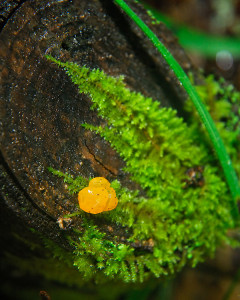
Fungi have been scarce this winter, but now the soils are saturated, we'll have to see what emerges in the next week or two
With the rains we’re also starting to see a hint of a few fungi re-emerging, like this Tremella sp. If this weather persists, we may still manage an extra ‘Mushroom Monday‘ post, or two, this season!
——————-
[1] Daniel E. Moerman’s Native American Ethnobotanical Database

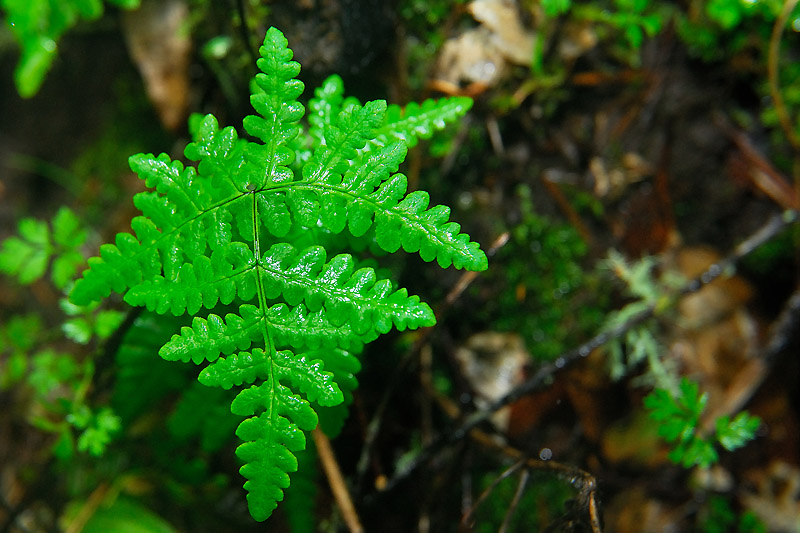
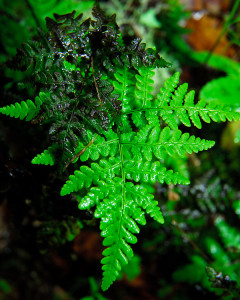
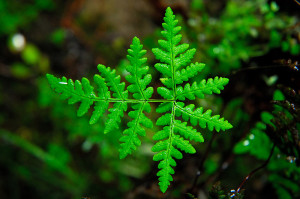

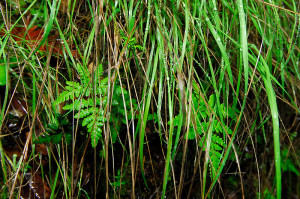
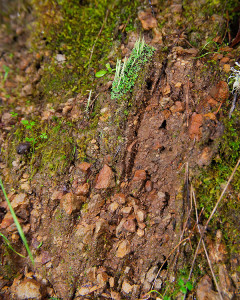


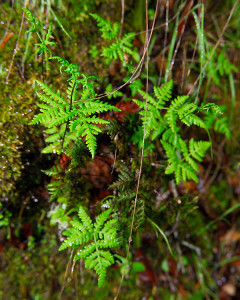
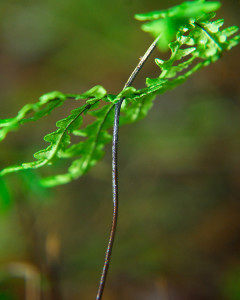



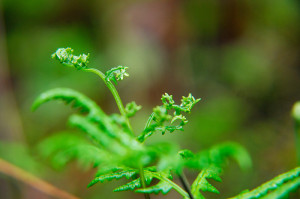
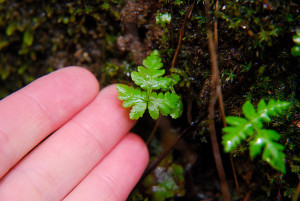
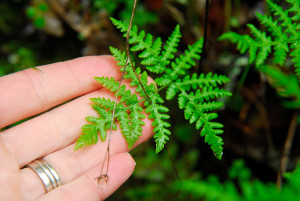
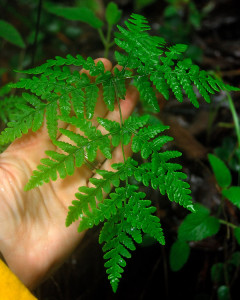











Gorgeous photos, as always. Love the closeup of the fern frond with your hand as perspective.
Your big rain is headed down the coast our way, due here sometime tonight. I bought some heirloom tomatoes at a special tomato and pepper sale today, but don’t have time to get them into the ground before the rain comes.
There was such a variation in frond size, it seemed I needed something for scale to show the difference. I’m happy to send you some rain, I’m actually getting a little tired of it. We need it, but an occasional break would be nice! 😉
I haven’t seen any ferns coming up other that the evergreen type here. I don’t know that I’ve seen this fern before. Sounds like the kids used them like the little temporary tattoos that kids have nowadays.
I’m really tired of rain, I haven’t checked to see where we are with rainfall, but I’m sure we’ve got to be over the average.
Our rain totals had us at less than 40% of ‘normal’ before this storm. Not sure how much we’ve caught up, but this is now the fifth straight day of rain. I miss the sun!
I love these little delicate ferns – great pictures you got. We have them mostly on the chaparral side of our property, on banks. I’m going to be looking for fungus too!
They seem to like the somewhat more exposed areas here too. They don’t grow in the shadiest places beneath the redwoods. They seem to prefer grassier areas, rather than growing alongside the other ferns here.
Hello Clare, I love all your little delicate ferns! We have quite a few varieties that grow well in the hills not far from here.
I think we have at least 5 different species of fern that grow here on their own. I’m very glad they volunteer so freely here, and am more than happy to encourage them. I’d go broke if I had to pay to plant all the ones we have! 😛
What a beautiful fern. Your photos are brilliant and really show the beauty of this delicate fern. I’m always amazed how the ferns I grow here come back here after long dry periods and even droughts.
Some of the banks here get very dry in summer. We don’t irrigate the areas where these ferns grow, so in the summer months they get no water at all. I suppose that’s the beauty of these ones, as they’re adapted to go dormant when conditions aren’t conducive to growth.
I love native ferns and this one is sweet! Looking at your photo of the underside of the fern I can really see how it is related to the maidenhair. You are fortunate to have so many growing at your farm. A testament of your good farming and gardening practices!
I wish our Maidenhair ferns (oh, that’s right…maybe we have 6 species of ferns here…I keep losing count) would grow as well as these little ferns. I’ve only found Maidenhair in one area here, at the foot of a redwood slope along our winter drainage area. Each summer it disappears, and each winter it comes back about the same size as the year before.
Clare, great to hear you are getting rain…I love ferns and am adding more native fern this year..what a great little fern you are lucky to have!!
It’s not terribly impressive from a distance, but I’m always happy to see them pop back in the winter months. Certainly a plant that you’d miss here if you weren’t actively looking for it! 😉
I love ferns,especially the fronds that come up before they unfurl. I don’t know this fern. Glad you explained the reasoning behind the name “goldback”. Very interesting. I was also surprised to see how small these ferns are – I’m used to seeing much larger ones. Glad to hear you’re getting some rain!
One thing I love about our native ferns, is they are completely deer proof! The deer don’t touch them, not even these little ones. I suppose when all else fails on the landscaping front, in my battle of wills with the deer, I can always plant a fern garden!
Beautiful fronds, I particularly like the black markings. When we were living in zone 8 I had a fern called a painted fern – Lady in Red I think. The veins were dark like this but red in colour. The contrasting colours are so eye catching and one of the best features was it was deer proof. Something I think you can relate to!
Oh yes, deerproof plants here definitely get my attention! 😉
Your beautiful fern reminds me much of my white-back fern, Celianthes argentea, which is just beginning to put up new fronds. I am still protecting it in a big pot, but I want to put it in the ground to see if it will grow.
I remember when you posted that fern. They really do look remarkably similar. It makes me wonder if when the taxonomists take a closer look at the genetics of these ferns, if they might not end up in the same Genus someday!
Interesting to read how it acquired its name! It certainly looks to be a more delicate fern in size compared to others and good the way that it can rejuvenate itself after a drought.
This fern, compared to our Western Sword Ferns, is absolutely tiny. They really don’t hold much presence on their own, unless there’s either a large mass of them, or they’re on a bank at about eye level. They are lovely though, and certainly worth a closer look!
Good-NESS! What a fantastic first photo! Wow! And how nice to have such a foresty spot with your own native ferns. There are Bracken ferns a thousand feet higher than us at Bass Lake, but I’ve tried to start some Western Sword fern here. It, though, would really like more moisture than we have here. Beautiful photos, Clare!
I had help from the spiders on that first pic. Those water droplets from our storm were all suspended on web silk. It just looked so interesting draped between the Sword Fern fronds.
This is so interesting…and such a beautiful fern. And I am so glad you got some rain. When it is dry, it causes so many problems and creates a lot of work.
Some of our plants certainly weren’t looking their best before the rain. I’m glad we’ve managed to catch up a little, and hopefully the plants will look better this spring for it too!